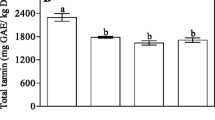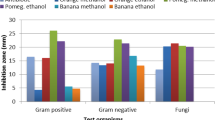Abstract
Pomegranate (Punica granatum L.) fruit is widely used in the food and process industries due to its excellent nutritional and health value and as a raw material for the manufacture of secondary products such as jellies, dyes, and cosmetics. The objectives of this research were to determine the vitamin C content and antimicrobial properties of fresh and dried fractions of fruit peel and arils of locally grown and imported pomegranate in Oman. A significant variation in vitamin C content was found among the five varieties of pomegranate studied, ranging from 52.8 to 72.0 mg/100 g fresh weight (fw) for arils and 76.8 to 118.4 mg/100 g fw for peels. Irrespective of the variety of pomegranate, vitamin C content in the peel was significantly higher than the aril, with differences ranging from 24.4% to 97.0% depending on variety. Fruit fractions showed antimicrobial effects (inhibition zone) on Staphylococcus aureus and Pseudomonas aeruginosa but not Escherichia coli. Sun drying of fruit peel significantly (p ≤ 0.05) enhanced vitamin C retention and antimicrobial effects in comparison with oven drying presumably due to lower rate of moisture removal associated with low temperature drying over longer duration in comparison with short-time high-temperature oven drying.





Similar content being viewed by others
References
Akiyama, H., Fujii, K., Yamasaki, O., Oono, T., & Iwatsuki, K. (2001). Antibacterial action of several tannins against Staphylococcus aureus. Journal of Antimicrobial Chemotherapy, 48, 487–491.
AOAC (2000). Vitamins and other nutrients (Chapter 45). In Official methods of analysis (pp. 16–20, 17th ed.). Washington, DC: AOAC International.
Braga, L. C., Shupp, J. W., Cummings, C., Jett, M., Takahashi, J. A., Carmo, L. S., et al. (2005). Pomegranate extract inhibits Staphylococcus aureus growth and subsequent enterotoxin production. Journal of Ethnopharmacology, 96, 335–339.
Cowan, M. M. (1999). Plant products as antimicrobial agents. Clinical Microbiological Review, 12, 564–582.
Dumlu, M. U., & Gurkan, E. (2007). Elemental and nutritional analysis of Punica granatum from Turkey. Journal of Medicinal Food, 10(2), 392–395.
Erenturk, S., Gulaboglu, M. S., & Gultekin, S. (2005). The effects of cutting and drying medium on the vitamin C content of rosehip during drying. Journal of Food Engineering, 68, 513–518.
Fadavi, A., Barzegar, M., Azizi, M. H., & Bayat, M. (2005). Physicochemical composition of ten pomegranate cultivars (Punica granatum L.) grown in Iran. Food Science and Technology International, 11, 113–119.
FDA (2007). Approximate pH of foods and food products. Rockville, MD: US Food and Drug Administration www.cfsan.fda.gov. Accessed 20 October.
Geckil, H., Gencer, S., & Uckun, M. (2004). Vitreoscilla hemoglobin expressing Enterobacter aerogenes and Pseudomonas aeruginosa respond differently to carbon catabolite and oxygen repression for production of L-asparaginase, an enzyme used in cancer therapy. Enzyme and Microbial Technology, 35, 182–189.
Gil, M. I., Tomas-Barberan, F. A., Hess-Pierse, B., Holcroft, D. M., & Kader, A. A. (2000). Antioxidant activity of pomegranate juice and its relationship with phenolic composition and processing. Journal of Agricultural and Food Chemistry, 48, 4581–4589.
Gracious, R. R., Selvasuramanian, S., & Jayasundar, S. (2001). Immunomodulatory activity of Punica granatum in rabbits. Journal of Ethnopharmacology, 78, 85–87.
Guo, C., Yang, J., Wei, J., Li, Y., Xu, J., & Jiang, Y. (2003). Antioxidant activities of peel and seed fractions of common fruits as determined by FRAP assay. Nutrition Research, 23, 1719–1792.
Khan, A., Rahman, M., & Islam, S. (2007). Antibacterial, antifungal and cytotoxic activities of tuberous roots of amorphophallus campanulatus. Turkish Journal of Botany, 31, 167–172.
Khodade, M. S., Wavhal, K. N., & Kale, P. N. (1990). Physico-chemical changes during the growth and development of pomegranate fruit. Indian Journal of Horticulture, 47, 21–27.
Le Loir, Y., Baron, F., & Gautier, M. (2003). Staphylococcus aureus and food poisoning. Genetics and Molecular Research, 2(1), 163–176.
Li, Y., Guo, C., Yang, J., Wei, J., Xu, J., & Cheng, S. (2006). Evaluation of antioxidant properties of pomegranate peel extract in comparison with pomegranate pulp extract. Food Chemistry, 96, 254–260.
Longtin, R. (2003). The pomegranate: Nature’s power fruit? Journal of the National Cancer Institute, 95, 346–348.
Lu, L., Chen, Y., & Chou, C. (2005). Antibacterial activity of propolis against Staphylococcus aureus. International Journal of Food Microbiology, 102, 213–220.
Madihassan, S. (1984). Outline of the beginning of alchemy and its antecedents. American Journal of Chinese Medicine, 12, 32–42.
Martinez, J. J., Melgarejo, P., Hernandez, F., Salazar, D. M., & Martinez, R. (2006). Seed characterization of five new pomegranate (Punica granatum L.) varieties. Scientia Horticulturae, 110, 241–246.
Morris, A., Barnett, A., & Burrows, O. (2004). Effect of processing on nutrient content of foods. Cajanus, 37(3), 160–164.
Mothershaw, A. S., & Jaffer, T. (2004). Antimicrobial activity of foods with different physico-chemical characteristics. International Journal of Food Properties, 7(3), 629–638.
Negi, P. S., & Jayaprakasha, G. K. (2003). Antioxidant and antibacterial activities of Punica granatum extracts. Journal of Food Science, 68, 1473–1477.
Özkan, Y. (2005). Investigation on physical and chemical characteristics of some pomegranate genotypes (Punica granatum L.) of Tokat Province in Turkey. Asian Journal of Chemistry, 17(2), 939–942.
Reddy, M. K., Gupta, S. K., Jacob, M. R., Khan, S. I., & Ferrira, D. (2007). Antioxidant, antimalarial and antimicrobial activities of tannin-rich fractions, ellagitannins and phenolic acids from Punica granatum L. Planta Medicine, 73(5), 461–467.
Sarkhosh, A., Zamani, Z., Fatahi, R., & Ebadi, A. (2006). RAPD markers reveal polymorphism among some Iranian pomegranate (Punica granatum L) genotypes. Scientia Horticulturae, 111, 24–29.
Singh, R. P., Chidambara Murthy, K. N., & Jayaprakasha, G. K. (2002). Studies on the antioxidant activity of pomegranate (Punica granatum L.) peel and seed extract using in vitro models. Journal of Agricultural and Food Chemistry, 50, 81–86.
SPSS (2000). Statistical package for Social Sciences. SPSS for Windows, Version 11.5, SPSS Inc., Chicago, IL, USA.
Stewart, C. M., Cole, M. B., Legan, D., Slade, L., Handeven, M. H., & Schaffiner, D. W. (2002). Staphylococcus aureus boundaries: Moving towards mechanistic predictive models based on solute-specific effects. Applied and Environmental Microbiology, 68, 1864–1871.
Styrt, B., & Klempner, M. S. (1988). Effects of pH on killing Staphylococcus aureus and Escherichia coli by constituents of the neutrophil phagolysosome. The Journal of Medical Microbiology, 25(2), 101–107.
Sumner, M. D., Elliott-Eller, M., Weidner, G., Daubenmier, J. J., Chew, M. H., Marlin, R., et al. (2005). Effects of pomegranate juice consumption on myocardial perfusion in patients with coronary heart disease. Journal of Cardiology, 96, 810–814.
Timoumi, S., Mihoubi, D., & Zagrouba, F. (2007). Shrinkage, vitamin C degradation and aroma losses during infra-red drying of apple slices. LWT—Food Science and Technology, 40, 1648–1654.
Vasconcelos, L. C. S., Sampaio, F. C., Sampaio, M. C. C., Pereira, M. S. V., Higino, J. S., & Peixoto, M. H. P. (2006). Minimum inhibitory concentration of adherence of Punica granatum Linn (pomegranate) gel against S. mutans, S. mitis and C. albicans. Brazilian Dental Journal, 17, 223–227.
Vega-Galvez, A., Lemus-Mondaca, R., Bilbao-Sainz, C., Fito, P., & Andres, A. (2008). Effect of air drying temperature on the quality of rehydrated dried red bell pepper (var. Lamuyo). Journal of Food Engineering, 85, 42–50.
Acknowledgment
This study was carried out under His Majesty’s Strategic Research Trust Fund as part of the project (SR/AGR/BIOR/05/01) awarded to Dr L.U. Opara (Principal Investigator) on Postharvest Technology of Fresh Produce. The authors are grateful for this financial support. We would like to acknowledge the reviewers of this manuscript for their valuable comments and suggestions.
Author information
Authors and Affiliations
Corresponding author
Rights and permissions
About this article
Cite this article
Opara, L.U., Al-Ani, M.R. & Al-Shuaibi, Y.S. Physico-chemical Properties, Vitamin C Content, and Antimicrobial Properties of Pomegranate Fruit (Punica granatum L.). Food Bioprocess Technol 2, 315–321 (2009). https://doi.org/10.1007/s11947-008-0095-5
Received:
Accepted:
Published:
Issue Date:
DOI: https://doi.org/10.1007/s11947-008-0095-5




